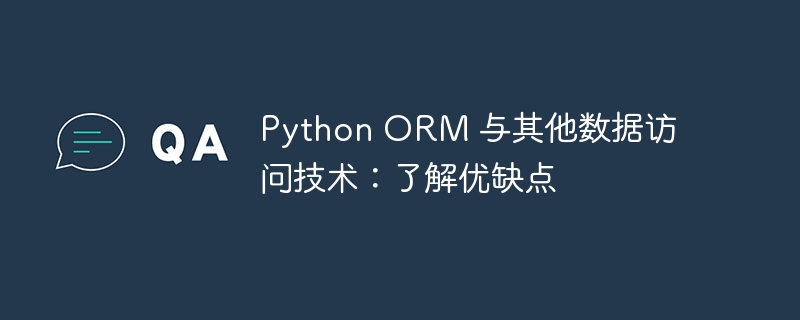
In python development, ORM (Object Relational Mapping) technology provides access and operation Powerful methods for database. However, it is not the only data access technology available. Other options include raw sql, Data Access Layer (DAL), and NoSQL database. It is crucial to understand the pros and cons of each technology in order to choose the most appropriate method for a specific project.
ORM
advantage:
-
Object-oriented: ORM uses objects to represent database entities, simplifying the mapping between data models and code.
-
Concise code: ORM automatically generates SQL queries, simplifying data access code and reducing errors.
-
Relationship management: ORM can automatically maintain the relationship between entities to achieve data integrity and consistency.
-
Support complex queries: ORM provides advanced query capabilities such as unions and aggregations without writing complex SQL.
shortcoming:
-
Scalability: ORM is optimized for relatively simple database designs and may encounter performance issues when scaling to complex or highly customized scenarios.
-
Database Abstraction: ORM hides the complexity of the underlying database, which can lead to unexpected behavior or performance issues.
-
Learning Curve: ORM libraries often have a long learning curve, requiring a deep understanding of their concepts and best practices.
Original SQL
advantage:
-
Performance: Raw SQL provides the most direct access to the database and is often faster than an ORM.
-
Flexibility: Raw SQL allows arbitrary queries to be written, providing full control over database functionality.
-
Portability: Raw SQL is database-independent and can be used on any database that supports SQL.
shortcoming:
-
Code redundancy: Original SQL requires all queries to be written manually, resulting in duplicate code and maintenance difficulties.
-
Error handling: Original SQL lacks the error handling function of ORM, increasing the possibility of errors.
-
Missing object mapping: Original SQL does not provide object mapping, and you need to manually convert database rows into objects.
DAL
advantage:
-
Code reusability: DAL separates data access logic from business logic to improve code reusability and maintainability.
-
Error handling: DAL usually provides a robust error handling mechanism to help identify and handle database exceptions.
-
Database independence: Some DALs can be used with a variety of databases to provide database-independent data access.
shortcoming:
-
Learning Curve: DAL has its own concepts and best practices, which requires a certain degree of learning curve.
-
Performance: DAL may introduce some performance overhead because it acts as a middle layer between the business logic and the database.
-
Low flexibility: DAL usually provides a predefined set of operations, limiting flexibility to the underlying database.
NoSQL Database
advantage:
-
Scalability: NoSQL databases are designed to handle massive amounts of non-relational data and provide excellent scalability.
-
Data model flexibility: NoSQL databases support a variety of data models, including documents, key-value pairs, and graphs.
-
Fast queries: NoSQL databases use optimized query engines specific to their data models, improving query performance.
shortcoming:
-
Consistency: NoSQL databases often sacrifice data consistency in exchange for performance and scalability.
-
Relational modeling: NoSQL databases are not suitable for modeling complex relational data and require different methods to handle relationships.
-
Learning Curve: NoSQL databases have different concepts and technology stacks that require a dedicated learning curve.
Choose appropriate data access technology
Choosing the best data access technology requires careful consideration based on the specific requirements of the project. Here are some guidelines:
-
For simple scenarios and situations where performance is critical: Raw SQL is the best choice.
-
For situations where object mapping and relationship management are required: ORM is preferred.
-
For situations where code reusability and error handling are required: DAL is a solid choice.
-
For situations where scalability and non-relational data processing are required: NoSQL databases are the best choice.
The above is the detailed content of Python ORM vs. other data access technologies: Understanding the pros and cons. For more information, please follow other related articles on the PHP Chinese website!






